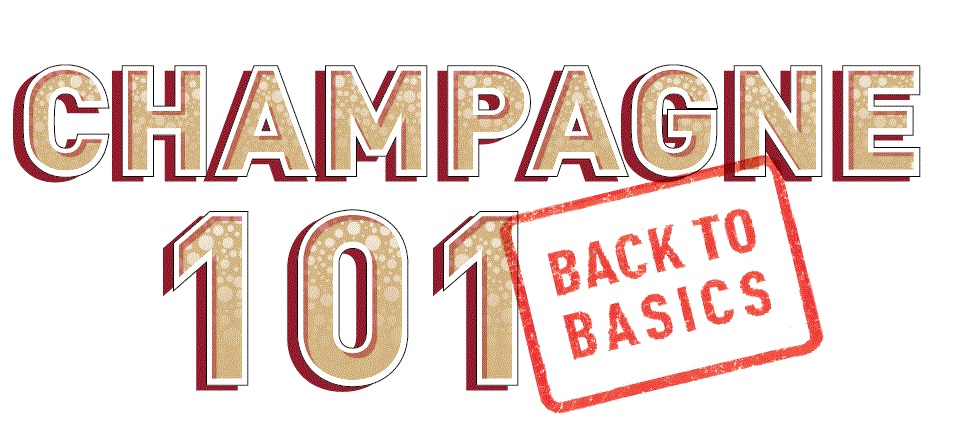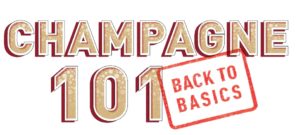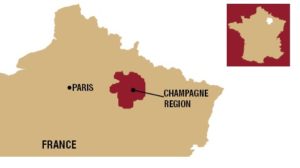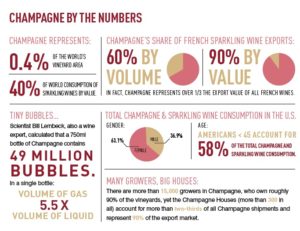
By Megan Krigbaum
 Champagne is a portrait in irony. Inarguably an icon of luxury, the liquid itself is more like a silk purse made from a sow’s ear; the now-famous method of nurturing a secondary fermentation in the bottle effectively compensates for the inability of grapes to ripen consistently in the (extremely) cool region.
Champagne is a portrait in irony. Inarguably an icon of luxury, the liquid itself is more like a silk purse made from a sow’s ear; the now-famous method of nurturing a secondary fermentation in the bottle effectively compensates for the inability of grapes to ripen consistently in the (extremely) cool region.
And while the grapes are farmed by thousands of small growers, production remains dominated by a relatively small number of Champagne houses. Champagne has not made headlines since the turn of the century, when fears of a Y2K shortage loomed (and proved unfounded). The price tag led Champagne to lose market share as the Recession played out; but while it has slipped from its 11.4% share of the sparkling wine market in 2005, it has held steady at 8% since 2010, according to IWSR, and posted a 3.5% growth in sales from 2014 to 2015.
Where is it Made?
 France’s Champagne (45 minutes on the train, due east from Paris) is one of the most northerly wine regions in the world, which means that it can be quite cold with unpredictable weather.
France’s Champagne (45 minutes on the train, due east from Paris) is one of the most northerly wine regions in the world, which means that it can be quite cold with unpredictable weather.
This means that there can be a great deal of vintage variation in the wines, one of the reasons that many producers like to make non-vintage (also called multi-vintage), blending wines from more than one year.
The Grapes
Three grape varieties, Chardonnay, Pinot Noir and Pinot Meunier, make up the bulk of plantings in Champagne, planted nearly in thirds throughout the region. There are actually four others that are permitted, but seldom used: Fromenteau, Arbane, Pinot Blanc and Petit Meslier. Together, these make up less than 1% of plantings.
Most Champagnes are a blend of red and white grapes Chardonnay (used for vibrance, floral and fresh fruit notes, like citrus and apple), Pinot Noir (lends a good bit of structure and earthiness to the wines), and Pinot Meunier (contributes red fruit flavors, like strawberry and raspberry).
How Champagne Is Made
There are several ways of producing sparkling wine, but the méthode champenoise, or Champagne method, has been replicated for centuries in regions around the world because it makes for complex and elegant wines, with finer mousse (bubbles), firmer
acid, a toasty character, more intensity a longer finish which preps it for food.
- Harvest: Despite being a very cool region, Champagne’s harvest is often earlier than many parts of Europe, with winemakers looking for vibrant acidity and lower
alcohol in the base wines. The Comité Champagne determines the first permitted day of harvest every year; in 2016 it began on September 10th. - Primary Fermentation: Champagne initially starts out just like any other wine, going
through fermentation in tanks. Some producers will age this base wine in barrel for a bit before bottling, but most go straight to bottle. - Bottling: For non-vintage bottlings winemakers will blend wines from at least a couple vintages to get the desired base. At bottling, yeast and sugar are added to the wine. Bottles are closed with a soda crown cap, as opposed to cork, because they can better withstand intense pressure. Bottles are then laid down in a cool, dark, humid cellar.
- Secondary Fermentation: Here come the bubbles. As the yeast consumes the sugar in the bottle, it produces CO2, which gets trapped in the bottle, creating the elegant fizz Champagne is so known for.
- Aging: At this point the Champagne will rest in the cellar for anywhere from 15 months or until the winemaker decides it’s ready forr elease. The lees (dead yeast cells) in the bottle contribute a nutty, toasty flavor and give texture to the wine, slowly with time.
- Riddling: Before corking, the cellared, crown-capped bottles are “riddled”—
either by hand or machine. This means that they’re turned just a little bit, periodically to keep the lees from sticking to the side of the bottle. - Disgorging: When it’s time to cork, the bottles are turned upside down to get all of those lees to settle in to the neck of the bottle. Most Champagne houses freeze the neck of the bottle, turning the lees into a little puck. When the caps are removed, they lees shoot right out—a method called disgorgement—resulting in
clear Champagne. - Dosage: Before corking, a little dosage of sugar mixed with still wine is added to top off the bottle and balance out the wine’s acidity and texture. The amount of sugar in the dosage defines the style indicated on the label, for example, Brut.
- Corking: Then, using a powerful machine the bottles are corked and the wire cages affixed.
To Dosage or not to Dosage
Over the past 10 years, Champagne has gotten drier and drier, with producers opting to add very little or no sugar to the dosage, making Extra Brut wines in a more focused style. This trend has been especially popular with smaller grower Champagne makers looking to give the wines the purest expression of their terroir. But larger Champagne houses are getting in the game, too, pointing to a shift in drinkers’ palates, with many people preferring wines that are light and lifted.
Disgorge Dating
Champagne ages more quickly when it’s off the lees, which means that there can be a substantial difference between bottles depending on their disgorgement dates. With this in mind, many houses have begun printing the date directly on the bottle so that consumers know how fresh to expect their wines to be.
Label Designations
 Dry vs. Sweet: The amount of sugar (measured in grams per liter, or g/L) in a Champagne’s dosage defines its technical level of sweetness, which is indicated by a range of terms:
Dry vs. Sweet: The amount of sugar (measured in grams per liter, or g/L) in a Champagne’s dosage defines its technical level of sweetness, which is indicated by a range of terms:
- Brut Nature: Also known as Pas Dosé or Dosage Zero contains no dosage and
less than 3 g/L of residual sugar - Extra Brut: Minimal dosage, leaving only up to 6 g/L
- Brut: Most Chamapagne falls in the Brut category, with 12 g/L or less residual sugar.
- Extra Dry: Counterintuitively, Extra Dry wines are actually sweeter than Bruts. These wines have between 12 and 17 g/L residual sugar.
- Sec: Getting sweeter, with 17-32g/L of residual sugar
- Demi-Sec: Demi-Sec Champagnes are perceptibly sweet and best served as
dessert wines or, with 32-50 g/L sugar. - Doux: The sweetest Champagne, registering 50+ g/L of residual sugar
Style
Most “standard” Champagnes are blends, both of vintages and grapes, but depending on varietal composition, a few other important stylistic designations may apply:
- Blanc de Noirs: These Champagnes are white, too, but they’re made from black grapes, Pinot Noir and Pinot Meunier, either blended or on their own.
- Blanc de Blancs: Whereas most Champagnes are made from a blend of red and white grapes, this style is made exclusively from Chardonnay. The name means white from white grapes.
- Rosé: Rosés are made one of two ways in Champagne: either from black (aka red) grapes left on their skins for a period to extract pink color; or from white Chardonnay, with some still red wine added in to give a rosy hue.
Vintage & Prestige Cuvees
 Non-vintage Champagne is vital not only to manage the variability of harvests, but also to maintain a “house style.”
Non-vintage Champagne is vital not only to manage the variability of harvests, but also to maintain a “house style.”
However, in good quality years, which generally occur three or four times a decade, producers may bottle wine made 100% from the harvest and indicate that vintage on the label. Rarer (only about 5% of overall production) and typically fuller (it has to rest three years before release, instead of 15 months), a producer’s Vintage Champagne is always more expensive than the NV.
In addition, houses separate their wines sourced from their very best vineyards in exceptional years to produce a prestige or Tête-de-Cuvée Champagne, representing their very best offering—often delivered in extra fancy packaging.
How to Serve Champagne
Temperature:
An ice-cold glass of Champagne can be incredibly refreshing, but it won’t offer up much aromatically. Look to serve most Champagne between 47 and 50˚F, which means pulled out of the fridge five or ten minutes before serving. With vintage Champagne, it’s nice to serve these a little warmer, to really allow the aromas to show off.
Glassware:
- The shallow, broad coupe glass—recalling the Roaring Twenties/Gatsby era—has fallen from favor because its large surface area allows bubbly to lose its fizz too fast.
- More recently, the tall, narrow flute has become the stem of choice largely because it showcases the tiny stream of bubbles or perlage of the wine.
- These days, many sommeliers are opting for white wine glasses; while perhaps not as festive, the ample bowl is considered better at allowing the wine’s aroma to be savored.
How to Open Champagne
- Start by removing the foil wrapping (pull on the tab if there is one).
- While holding the cork down firmly with one hand and tilting the bottle away from you (and others), untwist the wire loop at the base of the muzzle.
- Still holding the cork firmly, gently rotate the bottle with your other hand so that the cork comes sliding (not popping) out.
Selling Champagne
As much as everyone in the wine industry would love Champagne to be consumed with equal gusto year-round, Americans have proven again and again that bubbly remains a go-to for holidays and celebrations. Why fight it? “Popping the cork” brings joy, and Champagne remains an emblem of quality, so for special occasions, Champagne is exactly what merchants can and should be promoting. In the same vein, Champagne is a rock solid choice for gifting, at any time of year. In short, with its reputation as the best of the bubbly genre, Champagne is a vital staple in any wine merchant’s inventory or restaurant’s list.
Grower Champagne
For a long time, Champagne was largely dominated by big houses (grandes marques) that bought grapes from farmers throughout the region. While this is still common practice for the more well known brands, over the past 10 or 15 years, more and more wines from small family-owned wineries, that grow their own grapes, have become more popular on wine lists and in shops around the States. While the grandes marques certainly still control the business, these little guys have proven to make impressive, unique wines.
View, download and share the PDF version of Back to Basics: Champagne 101



